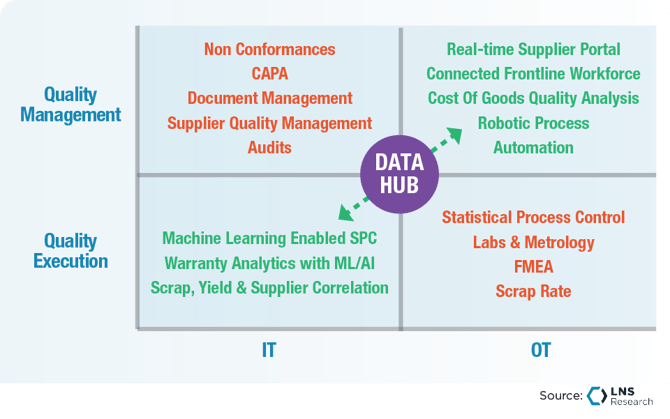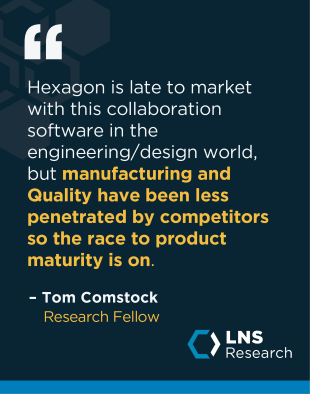Should Pharma Regain MES Leadership or Become the New IX Leaders?
Principal Analyst, Andrew Hughes, discusses the choice pharma companies need to make: regain their leadership in MES or become the new leaders in IX
LNS Research had the privilege to attend HxGN LIVE Global 2022 at the Venetian in Las Vegas. HxGN LIVE Global was Hexagon’s first in-person large-scale event since 2019 and drew over 2,000 customers and partners physically from thirty-four countries. The event included keynotes from executives across the company, exhibits, and an almost parallel media and analyst track allowing us to explore the company’s messages more deeply. LNS Research focused primarily on the Future of Manufacturing Summit but there were also tracks for Intelligent Mining, Digital Industrial Facilities, Connected Cities, and many others. All in all, the event had over 900 sessions over four days.
 Hexagon (Nasdaq Stockholm: HEXA B) offers design, measurement, and visualization technologies often combining sensor, software, and autonomous systems. The company has approximately 22,000 employees and net sales of approximately $4.3B EUR. President and CEO Ola Rollén [1] kicked off the event with a forward-looking keynote building on a quote and strategy from Marcus Aurelius 1,800 years ago. The Roman Emperor asserted that “what stands in the way becomes the way,“ meaning the impediment to action advances the action. Ola’s keynote used the example of how the industry has had to adapt to survive/succeed in the COVID era, thereby permanently changing the way we do business (virtually, work from home). He then said our generation was not going to be known for beating the virus but for how we deal with climate change. Asserting that the amount of CO₂ emitted into the air since 1990 is more than the amount from 1751 to 1990, he stressed that the problem was “us” not our parents, grandparents, or kids. Noting that 40% of natural resources are wasted through bad quality before final usage, he stressed sustainable businesses could be run more profitably. As we find ways around the impediments to sustainability, those would become our new ways of operating. He positioned Hexagon as critically important to industrials finding new ways.
Hexagon (Nasdaq Stockholm: HEXA B) offers design, measurement, and visualization technologies often combining sensor, software, and autonomous systems. The company has approximately 22,000 employees and net sales of approximately $4.3B EUR. President and CEO Ola Rollén [1] kicked off the event with a forward-looking keynote building on a quote and strategy from Marcus Aurelius 1,800 years ago. The Roman Emperor asserted that “what stands in the way becomes the way,“ meaning the impediment to action advances the action. Ola’s keynote used the example of how the industry has had to adapt to survive/succeed in the COVID era, thereby permanently changing the way we do business (virtually, work from home). He then said our generation was not going to be known for beating the virus but for how we deal with climate change. Asserting that the amount of CO₂ emitted into the air since 1990 is more than the amount from 1751 to 1990, he stressed that the problem was “us” not our parents, grandparents, or kids. Noting that 40% of natural resources are wasted through bad quality before final usage, he stressed sustainable businesses could be run more profitably. As we find ways around the impediments to sustainability, those would become our new ways of operating. He positioned Hexagon as critically important to industrials finding new ways.
We came to HxGN LIVE Global 2022 with a specific focus on ETQ, the AspenTech partnership, and to see their software strategy and roadmap. Let’s drill into each of these.
In February 2022, Hexagon announced the $1.2 billion acquisition of ETQ a leading provider of SaaS-based EQMS (Enterprise Quality Management System), safety, and compliance management software. The EQMS market has effectively divided into two segments: Life Sciences and “other” (i.e., all other industries). ETQ with its Reliance product set serves both segments and is the leader in the “other” segment including such industries as consumer products, healthcare, heavy manufacturing, electronics, food and beverage, heavy process, automotive, and more.
 The second-day keynote was the launch event for the acquisition. Rob Gremley, ETQ’s CEO and Morgan Palmer ETQ’s CTO spoke of the goal and promise of "connected quality,” linking enterprise-level quality management processes (non-conformance management, supplier quality, compliance reporting, etc.) to plant-level quality control processes (very much including metrology as delivered by Hexagon). Kimberly-Clark’s Ben Bollenbacher discussed their long-term, widespread implementation of ETQ Reliance, and Sara Hanks, from global rail manufacturer Wabtec, discussed how they leveraged both ETQ and Hexagon in their manufacturing operations.
The second-day keynote was the launch event for the acquisition. Rob Gremley, ETQ’s CEO and Morgan Palmer ETQ’s CTO spoke of the goal and promise of "connected quality,” linking enterprise-level quality management processes (non-conformance management, supplier quality, compliance reporting, etc.) to plant-level quality control processes (very much including metrology as delivered by Hexagon). Kimberly-Clark’s Ben Bollenbacher discussed their long-term, widespread implementation of ETQ Reliance, and Sara Hanks, from global rail manufacturer Wabtec, discussed how they leveraged both ETQ and Hexagon in their manufacturing operations.
LNS' quantitative and qualitative research has shown the power of integrating quality control and quality management data across the organization. In fact, we see it as a specific form of IT-OT Convergence as reflected in Figure 1. The potential of this acquisition is clear.
 Figure 1: Quality 4.0 & IT-OT Convergence
Figure 1: Quality 4.0 & IT-OT ConvergenceLNS Research sees four challenges for Hexagon in realizing that potential. First and most importantly, one of the reasons that ETQ is the leader in the “other” segment is that most of ETQ’s discrete competitors have been purchased by larger companies (PLM companies for example) and have competitively withered within these larger organizations. Hexagon will be challenged to keep ETQ focused on its core, specialized market while serving a broader parent. Second, while they share the same label, “Quality,” organizationally Quality Assurance and Quality Control are very disconnected in most manufacturers. There is little to no sales synergy across the two domains so it will be difficult to monetize their integration. Third, ETQ markets enterprise-level software as a solution that works across the company and the plants. Quality Control is typically a plant-level purchase, and that privilege is guarded jealously by the plant. Finally, Hexagon will not have sold all, or even most, of the Quality Control hardware or software in most plants so they will be filling only a portion of the “airgap” between QC and QA. The company will have to focus as actively on competitive and third-party systems to achieve the vision. ETQ has a long history of integrating with shop floor systems from an array of vendors and Hexagon has a track record supporting a diverse ecosystem for customers, so we don’t expect this to be a significant challenge.
While there is significant improvement to be had by implementing ETQ’s Reliance EQMS platform, and there is certainly some value in the connection with Hexagon’s universe of devices, manufacturers considering making this purchase should be aware that the connection between Hexagon and ETQ does not completely close the “air gap” between QA and QC. Additional connections to other data sources are needed to completely connect QA processes resident in ETQ’s Reliance platform with relevant contextual data that resides on the shop floor and/or Quality Labs that support QC functions in the plant.
LNS Research will be watching Hexagon closely to see if they can break from history and realize the potential in this significant acquisition.
Hexagon’s Chief Operating Officer and President of Hexagon’s Manufacturing Intelligence division, Paolo Guglielmini used his keynote to unveil Nexus, a platform to connect siloed engineering and unlock smart manufacturing innovation. In multiple drill-down sessions, the company positioned Nexus as enabling real-time data sharing and collaborative workflows between different design, simulation, and production applications. Hexagon Manufacturing Intelligence Division sees Nexus as the keyway to making its disparate software products work more seamlessly together. Nexus becomes the “platform” for the division’s software products.
Trends to follow as Nexus matures:
 Hexagon is positioning Nexus as a collaboration platform whereas competitors offer these same capabilities in products labeled Product Lifecycle Management (PLM). Hexagon is deliberately shying away from the PLM label as most of those competitors are controlling, versioning, and collaborating primarily across their own design (CAD, simulation) tools. Hexagon is positioning Nexus as tool-independent. LNS Research will be watching Nexus' positioning and product roadmaps carefully as there is a notable opportunity for PLM in the process industries where Hexagon Smart 3D is deeply penetrated. The simplicity of the user interface and workflows may make Nexus a strong solution for the SMB market which has not been well served by the PLM industry. These opportunities expand Nexus’ potential well beyond the integration platform of its initial position.
Hexagon is positioning Nexus as a collaboration platform whereas competitors offer these same capabilities in products labeled Product Lifecycle Management (PLM). Hexagon is deliberately shying away from the PLM label as most of those competitors are controlling, versioning, and collaborating primarily across their own design (CAD, simulation) tools. Hexagon is positioning Nexus as tool-independent. LNS Research will be watching Nexus' positioning and product roadmaps carefully as there is a notable opportunity for PLM in the process industries where Hexagon Smart 3D is deeply penetrated. The simplicity of the user interface and workflows may make Nexus a strong solution for the SMB market which has not been well served by the PLM industry. These opportunities expand Nexus’ potential well beyond the integration platform of its initial position.
Hexagon is leveraging Microsoft Fluid as the core collaboration and data sharing engine. This allows Hexagon to focus on the domain-specific requirements of PLM. Leveraging hyperscalers like Microsoft to deliver core infrastructure capabilities has served smaller IX Platform suppliers in adjacent markets to go to market faster and to build competitive advantage into their products. Hexagon is late to market with this collaboration software in the engineering/design world, but manufacturing and quality have been less penetrated by competitors so the race to product maturity is on.
Core to Enterprise Quality Management is document/data control and sharing; ETQ now offers forty-two applications built on/around these core capabilities. The question becomes: is there meaningful synergy between Nexus and ETQ that Hexagon can leverage? I am sure Nexus already has a robust product roadmap, so this is not a short-term question but becomes interesting over the longer term.
Users of Hexagon software products, particularly on the discrete side, should evaluate whether Nexus collaborative technologies offer value in their organization. Nexus was released as Version 1.0 during the event. Products this new require courage and a burning issue to support implementation so patient monitoring may be appropriate. I know LNS Research will be watching the maturation of Nexus carefully.
The biggest announcement at the 2019 version of HxGN LIVE was the announcement of a Memorandum of Understanding around a new collaborative partnership between Hexagon Asset Lifecycle Intelligence (ALI formerly PPM) and Aspen Technology. The vision was to link AspenTech’s conceptual, basic engineering and cost estimation solutions with the detailed engineering suite from Hexagon ALI. At the time, LNS Research viewed this as a potentially significant partnership as Hexagon ASL and Aspen Technology are leaders in their respective portions of asset lifecycle technology. We said “only time will tell” whether the potential of this partnership would be realized.
In a crowded breakout session, Sonali Stingh VP of Product Management for AspenTech detailed the progress the partnership has achieved since 2019. Highlighting three products that have been brought to market to provide a standardized and productized integration between the two product suites, she stressed that rubber was hitting the road. Stingh noted that the products had been successful with tens of beta customers and were now generally available.
Partnerships of market-leading companies seldom work because there is limited incentive for either company to invest in real product integration. Competitive and customer pressures appear to have pushed Hexagon and AspenTech to do the right thing. The partnership is gaining traction.
Current users of both AspenTech and Hexagon ALI should be engaging with these vendors to evaluate the potential of the integration for their organizations. These products are still early in their lifecycles but moving to productized integration can offer significant cost savings over time.
[1] The week after the conference Hexagon announced that Ola has been recommended to become Chairman of the Board and Paulo Guglielmini would become Hexagon’s next President and CEO.
All entries in this Industrial Transformation blog represent the opinions of the authors based on their industry experience and their view of the information collected using the methods described in our Research Integrity. All product and company names are trademarks™ or registered® trademarks of their respective holders. Use of them does not imply any affiliation with or endorsement by them.
As a member-level partner of LNS Research, you will receive our expert and proven Advisory Services. These exclusive benefits give your team:
Let us help you with key decisions based on our solid research methodology and vast industrial experience.
BOOK A STRATEGY CALLPrincipal Analyst, Andrew Hughes, discusses the choice pharma companies need to make: regain their leadership in MES or become the new leaders in IX
LNS Research Analyst James Wells recaps Sparta Connections 2022, providing highlights on key event topics, new software roll outs, and his...
There is some good news out there for Quality 4.0 initiatives but it's not all sunshine and roses either. Discover the do's and don'ts to ensure...
The Industrial Transformation and Operational Excellence Blog is an informal environment for our analysts to share thoughts and insights on a range of technology and business topics.